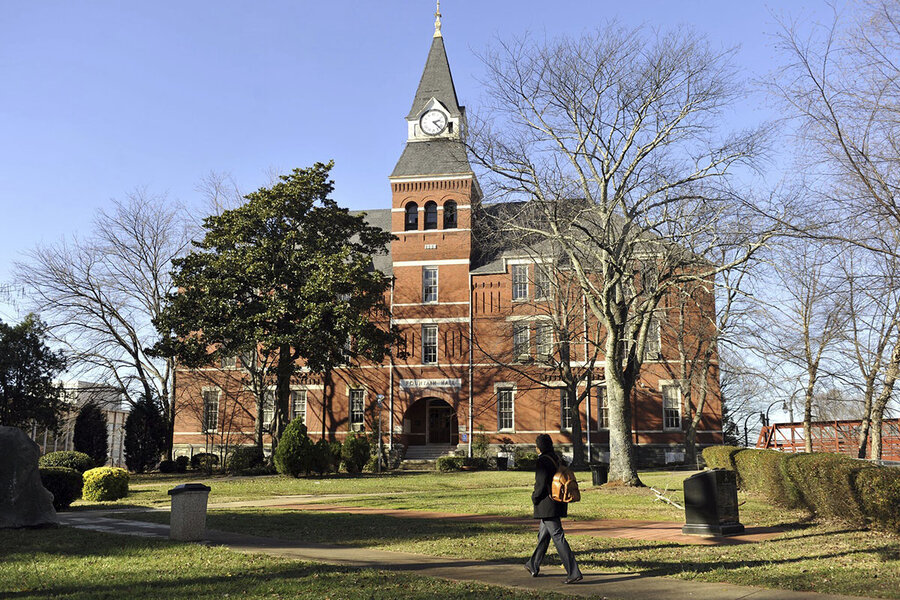Comeback college: How Morris Brown kept its doors open
Loading...
Kevin James once heard a sermon in church that gave a name to his mission: The Hard Reset.
That pretty much sums up his efforts to turn around a historically Black college in Atlanta. When he first started as president of Morris Brown College in 2019, there were only 20 students left. The college had lost accreditation in 2002 due to financial mismanagement. Morris Brown had filed for bankruptcy and sold 30 acres to pay down debt. The water had been shut off. Then, in Dr. James’ first semester, the administration building literally caught on fire.
No one donated money to fix it. In fact, many potential donors thought the school had closed.
Why We Wrote This
A story focused onAcross the U.S., the news has been about plummeting enrollment and small colleges shutting their doors. Here’s how one historically Black college turned it all around.
“No one would give me any money, but someone donated a can of paint,” Dr. James recalls. “And so the staff, we painted the walls ourselves. We did the Sheetrock work the best we could by ourselves.”
Today, 342 students are enrolled at Morris Brown – still just a fraction of the 3,000 who attended during its heyday. But the water is back on, debts have been paid, and in a rare outcome, the school won back its accreditation.
“One day they’ll film a movie about this, kind of like ‘Lean on Me’ or ‘Coach Carter,’ something like that – a real story of how Morris Brown was resurrected,” says Dr. James.
Morris Brown’s is a rare tale of survival. Closure – particularly after losing accreditation – is by far the more likely outcome for struggling smaller schools. Places such as 181-year-old Iowa Wesleyan University in Mount Pleasant, and 154-year-old Holy Names University in Oakland, California, ceased to exist in 2023. Faltering enrollments, which the pandemic exacerbated, helped shut many campus doors, according to a study done by Bloomberg News. According to Fitch Ratings, 20 to 25 schools with fewer than 5,000 students will close annually going forward. That’s double the previous 10-year average for private nonprofit schools.
“The loss of accreditation is a death knell for most institutions,” says John Drea, an assistant professor at Illinois State University who has written about what small colleges need to do to survive. “I’m pleasantly surprised Morris Brown has remained open. Unless a school has an enormous endowment or a network of donors to sustain it while it tries to regain accreditation, the loss of accreditation is what pushes a struggling college under. If a college is highly dependent upon tuition revenues from year to year to survive, one to two bad years can push you towards the precipice.”
There is some good news, and not just for Morris Brown: Overall undergraduate enrollment in the U.S. was up 2.1% in fall 2023 for the first time since the beginning of the pandemic, a report from the National Student Clearinghouse Research Center found. Historically Black colleges and universities, such as Morris Brown, saw even higher growth, with a 6.1% increase in undergraduates over 2022.
Making Morris Brown affordable and restoring students’ access to financial aid were two key tasks. (No accreditation meant no federal financial aid.) Typically, 70% of HBCU students qualify for aid. With only 20 undergraduates, one of Dr. James’ first steps was halving the 60-person staff.
“We weren’t making payroll,” Dr. James remembers, “and I had to make the very, very difficult decision of rightsizing the organization and living within our means.”
He asked the mostly adjunct faculty to volunteer and issued a call to action for alumni with Ph.D.s or master’s. More than 150 alumni raised their hands. From that number, volunteers taught for free for 2 ½ years, allowing the school to lower tuition. Currently, it stands at $4,250 a semester.
By 2022, the president had paid down debt, made new partnerships, and applied for accreditation from the Transnational Association of Christian Colleges and Schools. It was granted. The U.S. government then offered a $2.9 million grant to help grow enrollment.
“Just thinking about if they would have closed, what would the impact of the closure have been is huge,” says Stephanie Hall, acting senior director for the Center on American Progress who specializes in college accountability. Schools often just shut down operations and leave students without a plan or place for them to go.
Less than half of students at schools that close finish their degree, according to a 2020 study by the National Student Clearinghouse Research Center.
Shy’Quon Rudolph is a senior at Morris Brown. He sought out the school after initially enrolling at Tuskegee University in Alabama and dropping out after two years. Then he moved to Atlanta, where he was working full time.
“I can 100% say that if Morris Brown hadn’t had their accreditation, I probably wouldn’t have enrolled,” says Mr. Rudolph, who also works as an enrollment specialist and one day wants to be director of enrollment. Mr. Rudolph, 28, describes himself as a nontraditional student.
“By me just working in enrollment, I see the applications that we’re getting, the students actually interested in Morris Brown,” he says, predicting brighter days ahead for his school.
In 2023, Goldman Sachs released a study that showed that HBCUs had outperformed Ivy League schools in paving a way for upward social and economic mobility for Black Americans.
After winning back accreditation in spring 2022, Morris Brown saw the largest first-year student class in decades in fall 2023, totaling 150. Last semester, 342 enrolled. Alumni returned to celebrate homecoming. More people gave money. The first fraternity on campus in 20 years, Alpha Phi Alpha, restarted its chapter in October.
“I felt strongly that I would work to save the institution and that I would build a team for us to do it,” Dr. James says. Now The Hard Reset has a $10 million capital campaign. The Arthur M. Blank Family Foundation recently donated $3 million, and Chick-fil-A gave a $500,000 grant.
Other schools are looking at Morris Brown as a comeback model. Barber-Scotia College, an HBCU in Concord, North Carolina, lost its accreditation in 2004. Businessman and former Spring Lake mayor, Chris Rey, was hired as president last July. The school only had four students, so Mr. Rey suspended classes for fall 2023. Classes resumed online this January. As with Morris Brown, instructors are volunteering. Tuition has been lowered to $1,500 a semester, down from more than $7,000. Students can download all their books for $250.
“We’ve had an opportunity to really observe how [Dr. James] has leveraged his marketing and social media to bring attention to the story of Morris Brown College. That’s what we began to do,” Mr. Rey says. He’s taken mental notes on rebranding, communicating with stakeholders, and getting Barber-Scotia’s finances in order.
The work isn’t over for Dr. James, but he often reflects on the Sunday service that inspired him. His pastor used the analogy of doing a soft reset on a cellphone, where you turn it off to get things to work correctly.
“But then he was talking about if you need to restart ... you can do what’s called a hard reset. And you can wipe your entire cellphone clean, all the apps, everything would come off, and it would go back to factory settings. And that mindset came back to me as I was walking around the campus, and I was like, wow, what Morris Brown needs is a hard reset.”







